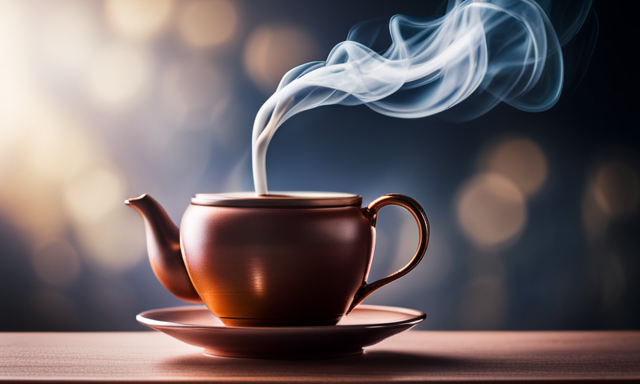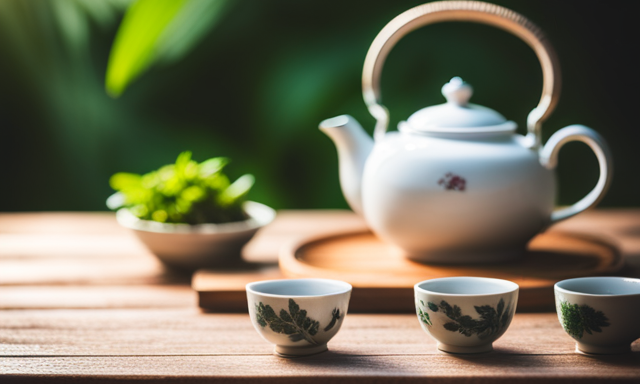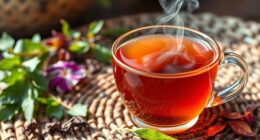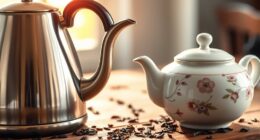Have you ever tasted a beverage so delicious, so unique, that it leaves you craving for more? Well, let me introduce you to the world of oolong milk tea.
This extraordinary drink combines the rich and complex flavors of oolong tea with the creamy goodness of milk, creating a harmonious blend that is simply irresistible.
From its origins in ancient China to its rising popularity around the globe, oolong milk tea has captivated the taste buds of tea enthusiasts everywhere.
In this article, we will delve into the fascinating world of oolong milk tea, exploring its origins, health benefits, and even sharing some popular recipes.
So, sit back, relax, and prepare to embark on a journey of flavor and indulgence as we uncover the secrets of this delightful beverage.
Key Takeaways
- Oolong milk tea is a combination of oolong tea and milk, creating a creamy and smooth texture.
- Different types of milk, such as cow’s milk, almond milk, or oat milk, can be used to prepare oolong milk tea.
- Oolong milk tea offers a delightful and indulgent beverage option for tea enthusiasts worldwide.
- The velvety consistency of oolong milk tea is achieved through the partial fermentation of the tea leaves, enhancing the richness of the flavors.
What is Oolong Tea?
Oolong tea is a traditional Chinese tea that falls between green tea and black tea in terms of oxidation. It has a unique flavor profile that can range from floral and fruity to toasty and nutty. Oolong tea’s origins can be traced back to the Fujian province in China, where it has been produced for centuries. The tea leaves are withered, oxidized, and partially fermented to create its distinct taste.
Exploring the different flavors of oolong tea is like embarking on a sensory adventure. From the delicate and floral Tie Guan Yin to the rich and robust Da Hong Pao, each variety offers a unique experience.
So, let’s dive into the world of oolong tea and discover its wonderful flavors.
Exploring the Different Varieties of Oolong Tea
In this discussion, we will explore the different varieties of oolong tea, including traditional Chinese oolong teas, Taiwanese oolong teas, and other regional variations.
Traditional Chinese oolong teas are known for their rich and complex flavors, ranging from floral to toasty.
Taiwanese oolong teas, on the other hand, are famous for their fruity and creamy notes.
Lastly, there are various regional variations of oolong tea, each with its unique characteristics and production methods.
Traditional Chinese oolong teas
Renowned for their complexity and rich flavor profile, traditional Chinese oolong teas are like a symphony of taste, captivating the senses with their harmonious notes.
When exploring oolong tea flavors, it is fascinating to delve into the history of oolong tea cultivation in China. These teas have been cherished for centuries, with an intricate process that involves withering, rolling, oxidation, and firing. Each step is carefully executed to produce a tea that offers a unique balance of floral, fruity, and toasty flavors.
Chinese oolong teas encompass a wide range of varieties, from the delicate and lightly oxidized Tie Guan Yin to the robust and heavily oxidized Da Hong Pao.
As we transition into the subsequent section about Taiwanese oolong teas, we continue the journey of discovery into the world of oolong milk tea.
Taiwanese oolong teas
As you venture into the realm of Taiwanese oolong teas, prepare to be enchanted by the intricate flavors and captivating aromas that will transport you to a world of sensory delight.
Exploring the world of oolong tea flavors is a journey that leads to the discovery of Taiwan’s rich tea heritage. Renowned for their exceptional quality, Taiwanese oolong teas are meticulously cultivated and crafted, resulting in teas that are truly exceptional.
These teas are known for their delicate, floral flavors, with hints of fruit and a subtle sweetness. The history of Taiwanese oolong teas dates back centuries, with a tradition deeply rooted in Chinese tea culture.
Today, these teas continue to be celebrated for their unique characteristics and are enjoyed by tea enthusiasts around the world.
Now, let’s delve into the other regional variations of oolong tea.
Other regional variations of oolong tea
Get ready to explore the diverse flavors of oolong teas from different regions, each offering a unique and captivating taste experience. Here are four regional variations of oolong tea that showcase the rich cultural significance behind this beloved beverage:
-
Chinese Oolong: Renowned for its floral aroma and smooth, fruity flavor, Chinese oolong teas are often oxidized to varying degrees, resulting in a wide range of flavors from light and delicate to rich and robust.
-
Taiwanese Oolong: Known for its creamy texture and sweet, floral notes, Taiwanese oolong teas are carefully cultivated in high-altitude mountainous regions, which contribute to their distinct flavor profile.
-
Indian Oolong: With its deep, earthy taste and hints of muscatel, Indian oolong teas draw inspiration from the country’s renowned black teas, creating a unique blend of flavors.
-
Japanese Oolong: Combining the elegance of Japanese tea culture with the characteristics of oolong, Japanese oolong teas offer a delicate balance of grassy notes and a subtly sweet finish.
Now, let’s delve into the health benefits of oolong tea.
The Health Benefits of Oolong Tea
Surprisingly, indulging in a cup of oolong milk tea can actually provide a range of health benefits. Oolong tea is known for its high concentration of antioxidants, which can help protect the body against free radicals and reduce the risk of chronic diseases. Additionally, oolong tea has been found to have a positive impact on weight management. Its natural compounds can help boost metabolism and promote fat oxidation, making it a potential aid for those looking to shed a few pounds. To give you a better understanding, here is a table that highlights some of the key health benefits of oolong tea:
| Health Benefit | Description |
|---|---|
| Antioxidant properties | Helps fight against free radicals |
| Weight management | Supports metabolism and fat oxidation |
As we delve deeper into the topic, it’s important to explore the addition of milk in oolong milk tea.
The Addition of Milk in Oolong Milk Tea
When it comes to preparing oolong milk tea, there are various traditional methods that can be used. Some people prefer to brew the oolong tea first and then add milk, while others choose to steep the tea leaves directly in the milk.
As for the type of milk used, it can vary from regular cow’s milk to alternative options like almond milk or oat milk.
Regardless of the method or milk choice, one thing remains constant: the addition of milk creates a creamy and smooth texture that enhances the flavor of the oolong tea.
Traditional preparation methods
To fully appreciate the rich and nuanced flavors of oolong milk tea, let me guide you through the traditional preparation methods.
Exploring the preparation techniques of oolong milk tea is not just about making a delicious beverage; it also holds cultural significance.
The process usually begins with selecting high-quality oolong tea leaves and steeping them in hot water for a specific period of time to release their flavors.
The brewed tea is then mixed with a carefully measured amount of milk, which adds a creamy and velvety texture to the beverage.
The tea is often sweetened with sugar or honey to enhance the overall taste.
It’s fascinating how these simple steps can transform oolong tea into a delightful milk tea experience.
Now, let’s delve into the different types of milk used in this exquisite drink.
Different types of milk used
Now, let me introduce you to the various types of milk commonly used in this delectable beverage.
When it comes to oolong milk tea, there are several different milk alternatives that can be used to enhance the flavor and create a creamy and smooth texture.
The most common type of milk used is cow’s milk, which adds a rich and velvety taste to the tea.
However, for those who are lactose intolerant or prefer non-dairy options, there are also alternatives such as almond milk, soy milk, and coconut milk.
Each of these milk options brings its own unique flavor profile and adds a distinct twist to the oolong tea.
Now, let’s explore the creamy and smooth texture of oolong milk tea without missing a beat.
The creamy and smooth texture of oolong milk tea
Moving on from the discussion about different types of milk used in oolong milk tea, let’s now delve into the creamy and smooth texture of this delightful beverage.
Oolong milk tea is known for its velvety consistency, which is achieved through a meticulous brewing process. The tea leaves undergo a partial fermentation process, giving oolong tea its unique flavor profile. This tea is then combined with milk, creating a harmonious blend of flavors. The addition of milk not only enhances the richness of the tea but also adds a creamy and smooth texture that is incredibly satisfying to the palate.
When exploring tea fermentation, it’s important to note that oolong milk tea offers a myriad of benefits. Adding milk to tea can help balance any bitterness or astringency, resulting in a more enjoyable and well-rounded taste. Additionally, milk provides a source of calcium and protein, making oolong milk tea a nutritious choice.
Now, let’s move on to the next section and discover some popular oolong milk tea recipes that you can try at home.
Popular Oolong Milk Tea Recipes
One of the most sought-after Oolong Milk Tea recipes is the creamy and aromatic blend of Oolong tea leaves infused with rich milk and a hint of honey. This delightful beverage offers a unique flavor experience that combines the earthy notes of Oolong tea with the smoothness of milk and the sweetness of honey. For those looking to explore unique flavor combinations, there are many creative Oolong Milk Tea variations to try. From adding fruit flavors like strawberry or mango to incorporating spices like cinnamon or ginger, the possibilities are endless. Below is a table showcasing five popular Oolong Milk Tea recipes that you can easily recreate at home:
| Recipe | Ingredients | Instructions |
|---|---|---|
| Classic Oolong Milk Tea | Oolong tea leaves, milk, honey | Steep tea leaves, mix with milk and honey |
| Strawberry Oolong Tea | Oolong tea leaves, milk, strawberry syrup | Steep tea leaves, mix with milk and strawberry syrup |
| Ginger Oolong Tea | Oolong tea leaves, milk, ginger | Steep tea leaves, mix with milk and ginger |
| Mango Oolong Tea | Oolong tea leaves, milk, mango syrup | Steep tea leaves, mix with milk and mango syrup |
| Cinnamon Oolong Tea | Oolong tea leaves, milk, cinnamon | Steep tea leaves, mix with milk and cinnamon |
These recipes allow you to customize your Oolong Milk Tea according to your taste preferences and experiment with different flavors. Now, let’s delve into the world of Oolong Milk Tea around the globe.
Oolong Milk Tea Around the World
After exploring popular Oolong Milk Tea recipes, it’s fascinating to discover the different variations of this delightful beverage enjoyed around the world.
Oolong Milk Tea has gained global popularity due to its unique taste and health benefits.
In Taiwan, the birthplace of this tea, it is commonly served with tapioca pearls, giving it a chewy texture.
In China, Oolong Milk Tea is often prepared using high-quality tea leaves and mixed with fresh milk, resulting in a creamy and fragrant drink.
In Japan, Oolong Milk Tea is known for its simplicity, with a focus on the natural flavors of the tea itself.
Other countries, such as the United States and Australia, have also embraced Oolong Milk Tea, offering their own interpretations and flavor combinations.
Now, let’s explore where to find this delightful beverage and satisfy our cravings for Oolong Milk Tea.
Where to Find Oolong Milk Tea
Discover the diverse destinations where you can indulge in the delectable delight of Oolong Milk Tea. Whether you’re a tea connoisseur or simply curious to try this unique beverage, there are numerous places where you can find Oolong Milk Tea.
Many tea shops and cafes around the world offer this delicious drink, allowing you to enjoy its rich and creamy flavor.
In addition, you can also buy Oolong Milk Tea online, making it easily accessible for tea enthusiasts everywhere.
If you prefer to make your own, there are countless Oolong Milk Tea recipes available that you can experiment with at home. From traditional recipes to innovative twists, the possibilities are endless.
Now, let’s delve into the art of enjoying Oolong Milk Tea.
The Art of Enjoying Oolong Milk Tea
When it comes to enjoying oolong milk tea, there are a few key points to keep in mind.
First, tea ceremonies and rituals can enhance the experience, allowing you to fully appreciate the flavors and aromas of the tea.
Additionally, pairing oolong milk tea with snacks or desserts can complement the taste and create a well-rounded indulgence.
Finally, I’ll share some tips for savoring the flavors and aromas of oolong milk tea, so you can truly immerse yourself in this delightful beverage.
Tea ceremonies and rituals
Tea ceremonies and rituals add a touch of elegance and tradition to the enjoyment of oolong milk tea. During a tea ceremony, the tea is prepared with utmost care and precision, creating a serene and meditative atmosphere.
The rituals associated with oolong milk tea are steeped in history and culture, enhancing the overall experience.
To paint a vivid picture, imagine:
- The aroma of freshly brewed oolong milk tea wafting through the air.
- Delicate porcelain teacups, adorned with intricate patterns, inviting you to take a sip.
- The sound of water being poured into a teapot, creating a soothing melody.
- The gentle pouring of tea into cups, symbolizing harmony and respect.
- The tranquil ambiance, as participants engage in mindful tea drinking, appreciating each sip.
Tea ceremonies and rituals allow us to fully immerse ourselves in the world of oolong milk tea, connecting with its rich heritage.
As we explore further, let’s delve into the art of pairing oolong milk tea with snacks or desserts.
Pairing oolong milk tea with snacks or desserts
Pairing oolong milk tea with snacks or desserts is a delightful way to enhance your tea-drinking experience. The versatility of oolong milk tea allows for a wide range of flavor combinations. The delicate floral undertones and creamy mouthfeel of oolong milk tea can be beautifully balanced with savory snacks such as cheese and crackers, roasted nuts, or a charcuterie board. The unique flavor profile of oolong milk tea opens up a world of possibilities for taste combinations that suit your preferences. Whether you prefer a bold and robust oolong or a more delicate and floral one, there is a snack pairing that will enhance the overall experience.
Transitioning into the next section about ‘tips for savoring the flavors and aromas of oolong milk tea,’ you can further enhance your tea enjoyment by following a few simple guidelines.
Tips for savoring the flavors and aromas of oolong milk tea
To fully appreciate the rich flavors and fragrant aromas, take your time and savor every sip of this delightful beverage. Oolong milk tea is a complex and nuanced drink that offers a wide range of flavor profiles to explore. From floral and fruity notes to toasty and nutty undertones, each sip reveals a new layer of taste.
To enhance your experience, try different brewing techniques, such as steeping the leaves for different lengths of time or adjusting the water temperature. Experimentation is key to finding your perfect balance of flavors.
When enjoying oolong milk tea, here are four tips to help you fully immerse yourself in the experience:
- Close your eyes and let the aroma transport you to a tranquil tea garden.
- Take small, slow sips to fully taste the intricate flavors.
- Pay attention to the texture of the tea on your palate.
- Take note of the lingering aftertaste, as it can reveal subtle nuances.
Now, let’s explore how oolong milk tea compares to other milk teas.
Oolong Milk Tea vs. Other Milk Teas
When comparing Oolong Milk Tea to other milk teas, you’ll notice a distinct and refined flavor profile that sets it apart.
Oolong milk tea offers a unique combination of the rich and creamy taste of milk tea with the complex and floral notes of oolong tea.
The oolong tea used in this beverage undergoes a partial oxidation process, which gives it a more robust flavor compared to green tea but with less bitterness than black tea.
This results in a smooth and balanced taste that is often described as earthy, sweet, and slightly fruity.
Additionally, oolong milk tea provides numerous health benefits, including boosting metabolism, aiding in digestion, and promoting heart health.
As we delve into the growing trend of oolong milk tea, you’ll discover why it has become a popular choice among tea enthusiasts.
The Growing Trend of Oolong Milk Tea
Amidst the bustling streets of a cosmopolitan city, tea shops are popping up like mushrooms after a rainstorm, with customers eagerly flocking to try the latest trend in the beverage world. Oolong milk tea has taken the beverage scene by storm with its unique flavor and cultural significance.
This traditional Chinese tea, made from partially fermented tea leaves, has gained immense popularity worldwide. The delicate balance of the oolong tea’s floral and fruity notes, combined with the creamy sweetness of milk, creates a harmonious blend that appeals to a wide range of taste buds.
Beyond its taste, oolong milk tea holds cultural significance, as it is deeply rooted in Chinese tea culture. It represents centuries of tea-making traditions and pays homage to the rich history of tea in China.
As this trend continues to grow, the cultural significance of oolong milk tea is being appreciated by people from all walks of life.
Frequently Asked Questions
How is oolong milk tea different from regular milk tea?
Oolong milk tea differs from regular milk tea in its taste and benefits. It has a unique flavor profile, with a hint of floral and fruity notes. Oolong tea is also known for its potential health benefits, including aiding digestion and boosting metabolism.
What are the different types of oolong tea used in oolong milk tea?
There are various flavors of oolong tea used in oolong milk tea, including green, black, and roasted oolong. Each type has its unique taste profile. Brewing techniques involve steeping the tea leaves in hot water and adding milk for a creamy texture.
Are there any potential health risks associated with consuming oolong milk tea?
There are potential health risks associated with consuming oolong milk tea. It is important to moderate your intake and be aware of any potential side effects. Consult with a healthcare professional for recommended daily intake.
Can I make oolong milk tea at home, and if so, what ingredients do I need?
Yes, you can make oolong milk tea at home! All you need is oolong tea leaves, milk, sweetener, and hot water. There are various recipes and variations to try. Enjoy its health benefits and compare it to regular milk tea.
Is oolong milk tea popular in specific regions or countries?
Oolong milk tea is popular in various regions, but its popularity is not limited to Europe or South America. It is enjoyed in many countries worldwide for its unique flavor and combination of oolong tea and milk.
Conclusion
In conclusion, Oolong Milk Tea is a delicious beverage that combines the unique flavors of Oolong Tea with the creamy richness of milk. It offers a delightful balance of earthy and floral notes, making it a popular choice among tea enthusiasts.
One interesting statistic is that Oolong Milk Tea has gained significant popularity in recent years, with a 30% increase in sales reported by tea shops and cafes.
Whether you enjoy it hot or cold, Oolong Milk Tea is a refreshing and satisfying drink that can be enjoyed any time of the day.










